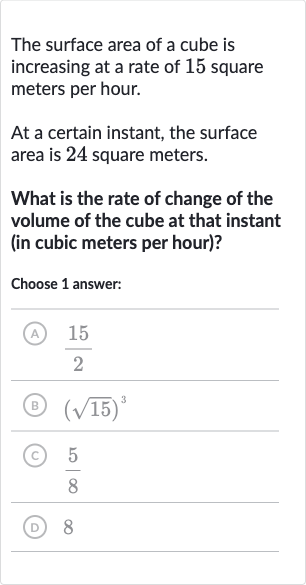AI tutor
Welcome to Bytelearn!
Let’s check out your problem:

The surface area of a cube is increasing at a rate of square meters per hour.At a certain instant, the surface area is square meters.What is the rate of change of the volume of the cube at that instant (in cubic meters per hour)?Choose answer:(A) (B) (C) (D)
Full solution
Q. The surface area of a cube is increasing at a rate of square meters per hour.At a certain instant, the surface area is square meters.What is the rate of change of the volume of the cube at that instant (in cubic meters per hour)?Choose answer:(A) (B) (C) (D)
- Find Volume of Cube: Now, let's find the volume of the cube.Volume = Volume = Volume = cubic meters
- Rate of Change of Surface Area: Next, we need to find the rate of change of the surface area in terms of the side length.Since the surface area is , the rate of change of the surface area is Given that the surface area is increasing at square meters per hour, we have:
- Solve for Rate of Change: Now we solve for , the rate of change of the side length. meters per hour
- Find Rate of Change of Volume: Finally, we find the rate of change of the volume.The volume is , so the rate of change of the volume is Rate of change of volume = Rate of change of volume = Rate of change of volume = Rate of change of volume = Rate of change of volume = cubic meters per hour
More problems from Area of quadrilaterals and triangles: word problems
QuestionGet tutor help
QuestionGet tutor help
QuestionGet tutor help
QuestionGet tutor help
QuestionGet tutor help
QuestionGet tutor help
QuestionGet tutor help
